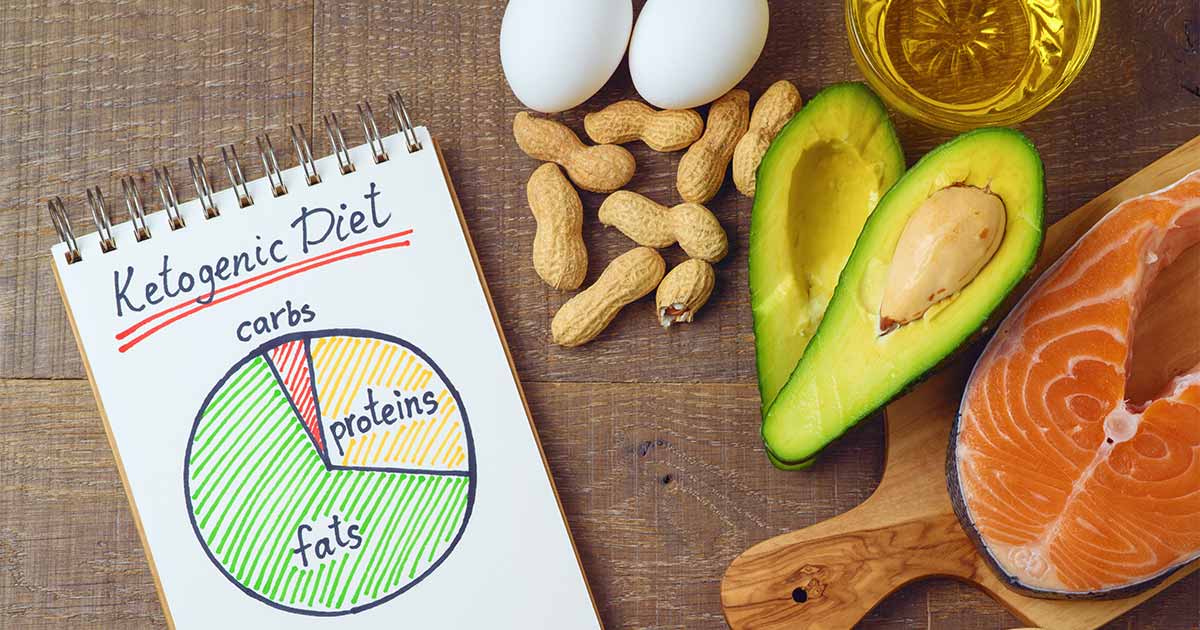Ketogenic Diet

What is the ketogenic diet?
The "classic" ketogenic diet is a special high-fat, low-carbohydrate diet that helps to control seizures in some people with epilepsy. It is prescribed by a physician and carefully monitored by a dietitian. It is usually used in children with seizures that do not respond to medications. It is stricter than the modified Atkins diet, requiring careful measurements of calories, fluids, and proteins. Foods are weighed and measured.
- The name ketogenic means that it produces ketones in the body. (keto = ketone; genic = producing) Ketones are formed when the body uses fat for its source of energy.
- Usually the body uses carbohydrates (such as sugar, bread, pasta) for its fuel. Because the ketogenic diet is very low in carbohydrates, fats become the primary fuel instead. The body can work very well on ketones (and fats).
- Ketones are not dangerous. They can be detected in the urine, blood, and breath. Ketones are one of the more likely mechanisms of action of the diet, with higher ketone levels often leading to improved seizure control. However, there are many other theories for why the diet will work.
Learn More:
Donate to Support Our MissionWebinar Recording
In a January 23, 2019 webinar, Dr. Elaine Kiriakopoulos, Dr. Eric Kossoff, and Registered Dietitian Zahava Turner talked about the history, components, safety, effectiveness, recent developments, and more related to the use of ketogenic diets in the treatment of epilepsy.
Who will it help?
- Doctors usually recommend the ketogenic diet for children whose seizures have not responded to several different seizure medicines.
- The classic diet is usually not recommended for adults, mostly because the restricted food choices make it hard to follow. However, the modified Atkins diet does work well. This also should be done with a good team of adult neurologists and dietitians.
- Find more information about adults and diets.
- Read an article about results from a large adult epilepsy diet center.
- The ketogenic diet has been shown in many studies to be particularly helpful for some epilepsy conditions. These include infantile spasms, Rett syndrome, tuberous sclerosis complex, Dravet syndrome, Doose syndrome, and GLUT-1 deficiency. Using a formula-only ketogenic diet for infants and gastrostomy-tube fed children may lead to better compliance and possibly even improved efficacy.
- Recent studies have also shown that infants can be successfully started on dietary therapy too.
- Read an article about the ketogenic diet for neonates.
- Learn about Ketogenic Guidelines for Infants.
- The diet works well for children with focal seizures, but may be less likely to lead to an immediate seizure-free result.
- In general, the diet can always be considered as long as there are no clear metabolic or mitochondrial reasons not to use it.
- The diet is sometimes started to help reduce or even stop anti-seizure drugs. However, that does not always occur – often it is a “partnership” between drugs and food to help reduce seizures that works.
What is it like?
- The typical "classical" ketogenic diet, called the "long-chain triglyceride diet," provides 3 to 4 grams of fat for every 1 gram of carbohydrate and protein. That is about 90% of calories from fat.
- Usually when the classic ketogenic diet is prescribed, the total calories are matched to the number of calories the person needs. For example, if a child is eating a 1500 calorie regular diet, it would be changed to a 1500 calorie ketogenic diet. For very young children only, the diet may be prescribed based on weight, for example 75 to 100 calories for each kilogram (2.2 pounds) of body weight. If it sounds complicated, it is! That’s why people need a dietician’s help when using this diet.
- A ketogenic diet "ratio" is the ratio of fat to carbohydrate and protein grams combined.
- A 4:1 ratio is more strict than a 3:1 ratio and is typically used for most children.
- A 3:1 ratio is typically used for infants, adolescents, and children who require higher amounts of protein or carbohydrate for some other reason.
- The kinds of foods that provide fat for the ketogenic diet are butter, heavy whipping cream, mayonnaise, and oils (e.g., canola or olive).
- Because the amount of carbohydrate and protein in the diet have to be restricted, it is very important to prepare meals carefully.
- No other sources of carbohydrates can be eaten.
- The ketogenic diet is supervised by
- a dietician who monitors the child's nutrition and can teach parents and the child what can and cannot be eaten
- a neurologist who monitors medications and overall benefits
What happens first?
- Typically the diet is started in the hospital. The child traditionally begins by fasting (except for water) under close medical supervision for 18-24 hours. The diet is then started, either by slowly increasing the calories or the ratio. (This is the typical Johns Hopkins Hospital protocol.)
- There is growing evidence that fasting is probably not necessary for long-term efficacy, although it does lead to a quicker onset of ketosis. Most centers today do NOT start with a fasting period.
- The primary reason for admission in most centers is to monitor for any increase in seizures on the diet, ensure all medications are carbohydrate-free, and educate the families.
Does it work?
Several studies have shown that the ketogenic diet does reduce or prevent seizures in many children whose seizures could not be controlled by medications.
- Over half of children who go on the diet have at least a 50% reduction in the number of their seizures.
- Some children, usually 10-15%, even become seizure-free.
Tell me more
- Children who are on the ketogenic diet continue to take seizure medicines.
- Some are able to take smaller doses or fewer medicines than before they started the diet. This is usually attempted after 1 month on the diet.
- If the person goes off the diet for even one meal, it may lose its good effect. So it is very important to stick with the diet as prescribed.
- Being on a diet allows for a sense of control over seizures by a parent (or person living with epilepsy). Many families comment on this and the how their ability to cook helps their child.
- Most major pediatric hospitals (and countries) have ketogenic diet centers – just ask!
Learn More:
Contact Our HelplineAre there any side effects?
- A person starting the ketogenic diet may feel sluggish for a few days after the diet is started. This can worsen if a child is sick at the same time as the diet is started.
- Make sure to encourage carbohydrate-free fluids during illnesses.
- Other side effects that might occur if the person stays on the diet for a long time are
- Kidney stones
- High cholesterol levels in the blood
- Constipation
- Slowed growth
- Bone fractures
Are any other medicine changes needed?
- Because the diet does not provide all the vitamins and minerals found in a balanced diet, the dietician will recommend vitamin and mineral supplements. The most important of these are calcium and vitamin D (to prevent thinning of the bones), B Vitamins, and selenium.
- There are no anticonvulsants (seizure medicines) that should be stopped while on the diet. Topiramate (Topamax) and zonisamide (Zonegran) do not have a higher risk of kidney stones while on the diet, but zonisamide can increase the chance of stones.
- Medication levels do not likely change while on the diet according to recent studies.
- All medications should be in as carbohydrate/sugar-free a form as possible to avoid hidden sugars. Most liquids are changed by pharmacists to pills.
How is the patient monitored over time?
- Early on, the doctor will usually see the child every 1 to 3 months.
- Blood and urine tests are performed to make sure there are no medical problems.
- The height and weight are measured to see if growth has slowed down.
Can the diet ever be stopped?
If seizures have been well controlled for some time, usually 2 years, the doctor might suggest going off the diet.
- Usually, the person is gradually taken off the diet over several months or even longer. Seizures may worsen if the ketogenic diet is stopped all at once.
- Children usually continue to take seizure medicines after they go off the diet.
- In many situations, the diet has led to significant, but not total, seizure control. Families may choose to remain on the ketogenic diet for many years in these situations.
Where can I find out more information about the diet?
- Epilepsy.com's Keto News includes summaries of cutting edge research and helpful hints for people with epilepsy, parents, and caregivers who receive or provide diets for the treatment of epilepsy.
- One book available is, "The Ketogenic Diet: A Treatment for Children and Others with Epilepsy," by Dr. Kossoff and his team, which discusses the Johns Hopkins approach and experience.
- The Charlie Foundation and Matthew’s Friends are parent-run organizations for support.
- Watch Dr. Eric Kossoff in "The Promise and Challenge of Dietary Therapy for Epilepsy" at the George Washington University Epilepsy Grand Rounds on March 8, 2016.
The Promise and Challenge of Dietary Therapy for Epilepsy - Dr. Eric Kossoff - 3/8/16
- In an interview for CNN en Español, Dr. Joseph Sirven explains the basics of the ketogenic diet. Find more information in Spanish about epilepsy here.
Resources
Epilepsy Centers
Epilepsy centers provide you with a team of specialists to help you diagnose your epilepsy and explore treatment options.
Epilepsy Medication
Find in-depth information on anti-seizure medications so you know what to ask your doctor.
Epilepsy and Seizures 24/7 Helpline
Call our Epilepsy and Seizures 24/7 Helpline and talk with an epilepsy information specialist or submit a question online.
Tools & Resources
Get information, tips, and more to help you manage your epilepsy.



